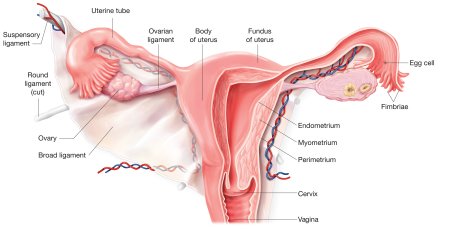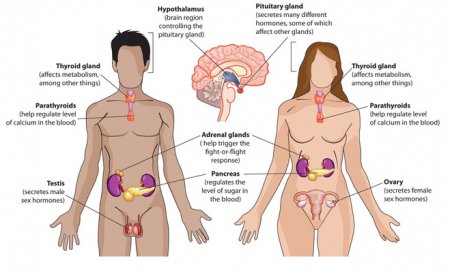The endocrine system
- Category: Endocrine system
- Views: 41566
The endocrine system includes all of the glands of the body and the hormones produced by those glands. The glands are controlled directly by stimulation from the nervous system as well as by chemical receptors in the blood and hormones produced by other glands. By regulating the functions of organs in the body, these glands help to maintain the body’s homeostasis. Cellular metabolism, reproduction, sexual development, sugar and mineral homeostasis, heart rate, and digestion are among the many processes regulated by the actions of hormones.
The uterus
- Category: Endocrine system, The female reproductive system
- Views: 188897
The uterus, also commonly known as the womb, is a hollow muscular organ of the female reproductive system that is responsible for the development of the embryo and fetus during pregnancy. An incredibly distensible organ, the uterus can expand during pregnancy from around the size of a closed fist to become large enough to hold a full term baby. It is also an incredibly strong organ, able to contract forcefully to propel a full term baby out of the body during childbirth.
The uterus is approximately the shape and size of a pear and sits in an inverted position within the pelvic cavity of the torso. It is located along the body’s midline posterior to the urinary bladder and anterior to the rectum. The narrow inferior region of the uterus, known as the cervix, connects the uterus to the vagina below it and acts as a sphincter muscle to control the flow of material into and out of the uterus.
The testes
- Category: Endocrine system, The male reproductive system
- Views: 154467
The testes (singular: testis), commonly known as the testicles, are a pair of ovoid glandular organs that are central to the function of the male reproductive system. The testes are responsible for the production of sperm cells and the male sex hormone testosterone. The testes produce as many as 12 trillion sperm in a male's lifetime, about 400 million of which are released in a single ejaculation.
The supraneal (adrenal) glands
- Category: Endocrine system
- Views: 79038
The supraneal, or adrenal, glands are a pair of glands that secrete hormones directly into the bloodstream. Each gland can be divided into two distinct organs. The outer region, the adrenal cortex, secretes hormones which have important effects on the way in which energy is stored and food is used, on chemicals in the blood, and on characteristics such as hairiness and body shape. The smaller, inner region - the adrenal medulla - is part of the sympathetic nervous system and is the body's first line of defense and response to physical and emotional stresses.
The ovaries
- Category: Endocrine system, The female reproductive system
- Views: 166249
The ovaries, a pair of tiny glands in the female pelvic cavity, are the most important organs of the female reproductive system. Their importance is derived from their role in producing both the female sex hormones that control reproduction and the female gametes that are fertilized to form embryos.
Each ovary is a small glandular organ about the shape and size of an almond. The ovaries are located on opposite sides of the uterus in the pelvic cavity and are attached to the uterus by the ovarian ligament. The open ends of the fallopian tubes rest just beyond the lateral surface of the ovaries to transport ova, or egg cells, to the uterus.
The endocrine glands of the lower torso
- Category: Endocrine system
- Views: 11951
Many important organs of the endocrine system are found in the abdominal and pelvic regions of the body, including the adrenal glands and the pancreas. These glands produce hormones that play vital roles in the body’s regulation of minerals, glucose, and energy allocation. The digestive and excretory organs of this region also produce hormones to manage digestion, blood cell production, and mineral homeostasis as well.
The adrenal glands are a pair of triangular glands that are located along the superior edge of the kidneys. Each gland consists of two regions - an outer cortex and an inner medulla - that have distinct structures and functions within the gland. The medulla produces the stress hormones epinephrine (adrenaline) and norepinephrine (noradrenaline) under stimulation by the sympathetic division of the autonomic nervous system (ANS). These hormones help to augment the body’s “fight or flight” response to stress and exertion by increasing the heart’s blood output to the muscles; increasing the efficiency of the lungs; and releasing energy for the muscles to use.
The thymus gland
- Category: Endocrine system, Immune and lymphatic systems
- Views: 166290
The thymus gland, despite containing glandular tissue and producing several hormones, is much more closely associated with the immune system than with the endocrine system. The thymus serves a vital role in the training and development of T-lymphocytes or T cells, an extremely important type of white blood cell. T cells defend the body from potentially deadly pathogens such as bacteria, viruses, and fungi.
The thymus is a soft, roughly triangular organ located in the mediastinum of the thoracic cavity anterior and superior to the heart and posterior to the sternum. It has two distinct but identical lobes that are each surrounded by a tough, fibrous capsule. Within each lobe is a superficial region of tissue called the cortex and a histologically distinct deep region called the medulla. Epithelial tissues and lymphatic tissues containing dendritic cells and macrophages make up the majority of both regions of the thymus.
The endocrine system of the upper torso
- Category: Endocrine system
- Views: 4648
The endocrine system of the thorax contains only one gland, the thymus, but several other hormones are produced in this region by tissues containing endocrine cells. These hormones work to control aspects of the body’s immune, cardiovascular, and digestive systems.
The thymus gland is a small, triangular gland located deep to the sternum and superior to the heart. It forms a key component of the immune system that trains and develops T lymphocytes (T cells) to fight off infections. A class of hormones known collectively as thymosins are produced by the thymus and used to stimulate the production and development of T cells during childhood and puberty.
The thyroid gland
- Category: Endocrine system
- Views: 79508
The thyroid gland is a butterfly-shaped organ located in the base of your neck. It releases hormones that control metabolism—the way your body uses energy. The thyroid's hormones regulate vital body functions, including:
- Breathing
- Heart rate
- Central and peripheral nervous systems
- Body weight
- Muscle strength
- Menstrual cycles
- Body temperature
- Cholesterol levels
The thyroid gland is about 2-inches long and lies in front of your throat below the prominence of thyroid cartilage sometimes called the Adam's apple. The thyroid has two sides called lobes that lie on either side of your windpipe, and is usually connected by a strip of thyroid tissue known as an isthmus. Some people do not have an isthmus, and instead have two separate thyroid lobes.
The pituitary gland
- Category: Endocrine system
- Views: 90006
The pituitary gland is a pea-sized gland located in the center of the skull, inferior to the hypothalamus of the brain and posterior to the bridge of the nose. It is an important link between the nervous and endocrine systems and releases many hormones which affect growth, sexual development, metabolism and human reproduction.
The pituitary gland, also known as the hypophysis, is connected to the hypothalamus of the brain by a tiny isthmus of nervous tissue called the infundibulum. It sits within a small cavity in the sphenoid bone of the skull known as the hypophyseal fossa. Thus the sphenoid bone surrounds and protects the delicate pituitary gland from damage by external forces.









